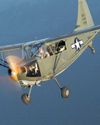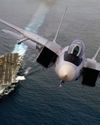Denemek ALTIN - Özgür
Flying Jackets
Flight Journal
|October 2018
History’s love affair with the aviator’s best friend.

A CRITICAL LOOK BACK on aircraft design and aviation flight clothing reveals continual advances in technology that yielded higher performance, safety, and comfort. Yet over the last 80 or so years, the leather flight jackets worn originally by U.S. Navy, Marine Corps, and Army Air Force aviators in the 1940s have remained relatively true to the original designs, despite considerable advances in every aspect of aviation flight clothing and protective equipment.

Flight Gear at the Beginning: World War I
As the war clouds of WW I loomed on the horizon, aviators did not have special flight clothing and typically flew with whatever uniform was prescribed as the uniform of the day. Throughout the world’s air forces, this widespread practice dates back to the origins of flight when Orville and Wilbur Wright flew their Flyer wearing suits and ties; WW I aviators flew in their service dress jackets with “choker”-style collars. It was no wonder that silk scarves were introduced to protect necks from chafing.

The common-day suit of the time sufficed for the early flights of limited duration, speed, and altitude. As speeds increased and aircraft pushed ever higher for longer flights, aviating became progressively more inhospitable owing to wind blast and the cold temperatures at altitude. Aviators turned to the only available sources of robust protective clothing: sports-equipment suppliers and “outfitters,” whose tailors had produced specialized clothing for years for use by expeditions venturing into the Arctic cold and the high altitudes of unconquered summits.
Bu hikaye Flight Journal dergisinin October 2018 baskısından alınmıştır.
Binlerce özenle seçilmiş premium hikayeye ve 9.000'den fazla dergi ve gazeteye erişmek için Magzter GOLD'a abone olun.
Zaten abone misiniz? Oturum aç
Flight Journal'den DAHA FAZLA HİKAYE

Flight Journal
ELLIPTICAL ELEGANCE
Flying and evaluating the Seafire Mark III
4 mins
November - December 2025

Flight Journal
IRON DOG
Fighting the Pacific and the P-39 at the same time
14 mins
November - December 2025

Flight Journal
Fighter Pilots: A Warrior Clan
TAKE A HARD LOOK at the two young men in these photos. Do they look as if they were bent on killing one another? On the left we have a young, unknown enlisted Japanese pilot standing in front of a Nakajima Ki-27 \"Nate,\" one of Japan's earliest monoplanes that led to the much vaunted Zero.
3 mins
November - December 2025

Flight Journal
KEN WALSH THE FIRST CORSAIR ACE
Medal of Honor pilot's combat adventures
12 mins
November - December 2025

Flight Journal
Big Chief's Little Chief
Thunderbolt action with the Wolf Pack
11 mins
November - December 2025

Flight Journal
ENEMY PILOTS SPEAK Voices from the other side
All too often American students of air warfare forget that enemy aircraftwhether Messerschmitts or MiGs-were flown by human beings with the same motivations and traits as Allied airmen. More often than not, the only difference between friend and foe was the paint on the airplane and where they landed. Therefore, we've assembled a variety of accounts from WW II Axis fighter pilots, men who were more than simply targets.
11 mins
November - December 2025

Flight Journal
FLYING THE FW 190
A legend gets checked out in the Butcher Bird
15 mins
November - December 2025

Flight Journal
DOUBLE-THEATER ACE
The fearless missions of legendary fighter pilot Col. John D. Landers
12 mins
November - December 2025

Flight Journal
WARBUG IN THE PACIFIC
Surviving combat in a Stinson OY-1/L-5
10 mins
September - October 2025

Flight Journal
WINGS OF THE FLEET
Celebrating the U.S. Navy's 250-year legacy
9 mins
September - October 2025
Translate
Change font size

